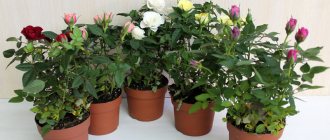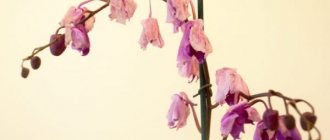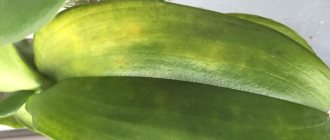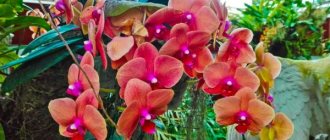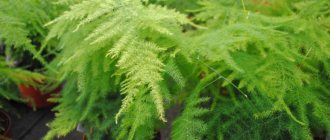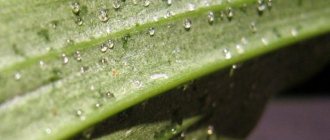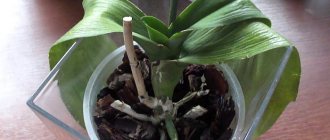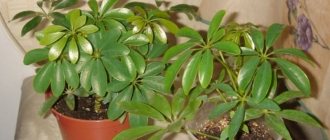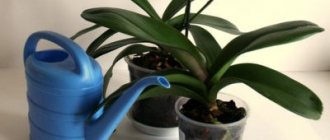Plants » Flowers
4
4314
Article rating
Kira Stoletova
Many who grow phalaenopsis are interested in why the orchid stem dries out and how to save the flower. If the orchid's stem has turned yellow, the main source of the problem is natural aging. There are other factors that affect the condition of the stem.
Why does the orchid stem dry out?
Changing the color of the growth point
The top leaf of monopodial orchids is called the growing point. Its yellow color means a deviation from the norm; the plant has health problems. The reason for this phenomenon is uncomfortable conditions for keeping exotic plants and improper watering. Also a consequence of damage to the flower by infection. If this leaf is severely wounded, the orchid stops growing upward.
Many people believe that without a growing point, a plant cannot survive. It can, but the probability is not 100%. Finding itself without an active core, the exotic is susceptible to fungal diseases. If he has enough strength to overcome ailments, the plant will survive. The flower can produce a lateral shoot on the stem or peduncle, thus continuing to grow.
What to do to save the plant?
If the unexpected happened, the orchid trunk began to turn yellow, its natural state changed, and definitely some problems arose. No need to wait, respond urgently:
- Conduct a thorough visual inspection of the diseased plant.
- Change the orchid's living parameters.
- Control the quality and frequency of watering. Water should not remain in the leaf axils.
Find out what is causing this condition.
If the measures described above did not produce any changes, we proceed to more radical ones:
Prepare pruning tools and disinfect them.
- Remove any damaged tissue.
- Treat the cuts with ground cinnamon or crushed activated carbon.
If the leaves fall in addition to the yellow stem, perhaps this process is another symptom of rot or an infectious disease. In such cases it is necessary:
- treat the soil and plant with a 0.2% solution of Fundazol or Topsin;
- pour the drug directly into the wound of the plant;
- We carry out the procedure at least three times with an interval of 14 days;
- regularly inspect the diseased flower for signs of rotting;
- the buds on the peduncle can be treated with cytokinin hormonal paste to stimulate the appearance of children.
Prevention
During the first time after amputation, be sure to adhere to the following recommendations.
- The first thing is to remove it from the southern window sill or shade the light with a tulle curtain. In autumn and winter, provide artificial lighting. The duration of daylight hours should be 10-12 hours.
- Three times – maintaining a comfortable temperature in summer: +22-25ºС. Do not place under air conditioning or leave in a draft; the plant may become overcooled. In winter +16-18ºС. Do not place near heating radiators.
- Third, the difference in temperature differences should not exceed 5ºС. At temperatures above +25°C and high humidity, fungal infections develop, and at temperatures below +15ºC – bacterial infections.
- Use a household humidifier to maintain humidity within 50-60%.
- Provide regular ventilation.
- Moisten the flower once every 7-10 days; in between, the soil should dry completely.
- Carefully ensure that moisture does not remain on the leaves. After watering, remove stagnant water from the leaf axils.
- Avoid the use of mineral preparations for the first time after the procedure. In the future, use nitrogen fertilizers during active growth, potassium and phosphorus fertilizers during the flowering period.
Diseases and pests as the cause of yellowing leaves
Possible causes of wilting and yellowing orchid leaves may be pests or diseases. The tropical flower is a tasty morsel for all known household pests. If signs of disease or parasites are detected, the orchid must be isolated from other flowers.
Common sores cling to orchids when temperature, watering and lighting are violated, or from infected plants. Fungal, viral or bacterial infections lead to dark yellow spots or mycelium bumps. Asian orchids often suffer from fungal infections. A flower can pick up the virus at a time of stress during transportation and a change in care regime, which manifests itself as dark rings on the leaves.
Pests dangerous to orchid leaves:
- the spider mite organizes its thin web under the leaf and on the shoots;
- aphids love the inside of the leaf blade, making it sticky to the touch;
- growths indicate the presence of a scale insect, which can be seen with a magnifying glass;
- translucent winged thrips settle on the orchid at low air humidity, they leave a silvery layer on the leaves, shoots and substrate;
- leaf deformation and growth arrest indicate damage to the orchid by nematodes;
- woodlice attacks orchids in outdoor conditions.
Natural process
The part of the plant called the stem depends on the type of flower. For example, in phalaenopsis the stem is usually considered to be the peduncle, while in dendrobium it is the bulb. In order for an orchid to delight with new flowers and feel good, it requires proper care. Knowledge of the basic features of keeping them will help you avoid problems, namely, all Phalaenopsis are susceptible to new conditions and are afraid of changing their habitat.
Slightly yellowed lower leaves of phalaenopsis are considered common. Green leaves live for a certain period, namely from 3 to 5 years, after this period the leaf gradually becomes soft, fades, turns yellow, and soon dries out. It is also natural to see a situation where the faded stem of an orchid has dried up.
After the plant has produced buds, and then has flowered safely and dropped them only after 3-6 months, events can develop in two ways:
- the peduncle continues to be green and is preparing to bloom again;
- The stem is already yellow and needs pruning.
Most often, after acquiring a beautiful flowering phalaenopsis, you will notice that it begins to drop its flowers, the buds turn yellow, and then the orchid’s stem turns yellow. This suggests that the plant has suffered stress due to a change in conditions and place of residence. However, phalaenopsis quickly gets used to its habitat and soon grows green mass and roots. And then the growing season begins and soon the plant produces a new peduncle.
If the orchid stem has turned yellow, you can cut off the yellowed stem completely or just to the next dormant bud.
- If the peduncle has dried out and turns yellow to a certain area, but is still partially alive, then the flower has decided to release a baby from a bud or a side peduncle. The side shoots do not bloom so profusely, so to speak - sparingly.
- Completely cut off the peduncle, which has already faded from the crown, so that their bush in the future will spend energy only on large and harmonious flowering.
Orchid leaves turn yellow from sunburn
The leaves of an orchid turn yellow if the plant is on the south or west side in hot weather. The leaf gets sunburn, the area affected by the rays turns yellow over time and gradually dries out, but does not spread further. It is necessary to protect the orchid from direct sunlight.
When the plant does not have enough light, the orchid's leaves turn yellow at the base and then die. The junction of the leaf and the stem may be affected. In this case, the diseased leaf must be removed, and the top must be cut off if the stem has turned black. The cut areas can be treated with iodine or brilliant green, and the instruments must be disinfected.
The growing point withers
Also, sometimes an unpleasant problem arises with phalaenopsis - the growing point may begin to die. An orchid is a monopodial plant; it has only one growing point. If it dies, then unfortunately the plant cannot be saved. To prevent this from happening, you need to remember the causes of death and try to adhere to the rules of cultivation. The most popular reason remains rotting.
Phalaenopsis loves warmth and does not tolerate excess moisture. In just 24 hours, almost the entire root system will rot if it is in water. After watering, be sure to empty all the water from the trays so as not to lose your favorite flowers. If all the leaves begin to fall off and their color acquires a putrid dark hue, this means that the growing point has rotted. The neck also becomes dark in color and soft to the touch.
Drying out also causes the death of the growing point, only the plant dies more slowly. Phalaenopsis can easily do without water for a long time, but no more than a couple of months. Over time, the bush shows signs of dehydration, the leaves begin to turn yellow, the roots die, and eventually die. If the stem of an orchid has turned yellow and all the leaves have fallen off, but there are doubts that the growing point has died, you should leave the pot with the root system alone for several months, because there is still a possibility that the lateral cervical baby will sprout and then not everything will be with the flower lost.
Yellow leaves - are they dangerous?
There should be cause for concern only if the leaves turn yellow too often, even when young, and if the yellowing covers a significant part of the plant's body. And also if there are any side effects - roots rot, buds fall off, etc.
To know for sure whether everything is okay with your orchid, experts recommend remembering how long the leaves of your orchid variety live. For example, if it is a phalaenopsis, then the “plumage” changes at least once a year. First the leaves turn yellow, then dry out, lose their shape and fall off. That is, if your phalaenopsis began to shed its lower leaves, know that everything is in order, it is just getting rid of dead cells. If we are talking about dendrobium, it is worth remembering that the norm for it will be to change leaves twice a year, most often immediately after it has bloomed, but sometimes during the dormant period.
Trimming
A faded orchid must be pruned according to the rules so as not to destroy the plant.
When is it time to prune an orchid?
The time from the beginning of October to November inclusive is considered the best period for carrying out this procedure, and it is suitable for almost any type of this wonderful plant. But exotic species (artificial hybrids) are pruned only in the spring, from the first days of March until the end of the month. The name of the flower indicates whether it is a hybrid or an original variety.
Therefore, when purchasing a phalaenopsis for yourself, be sure to pay attention to the name (or write it down) because its entire future life in the house will depend on it.
Using tools when pruning
Oddly enough, but metal scissors or simple garden pruning shears - pruning shears - are better suited for this.
Be sure to disinfect the instrument you decide to use with a solution of ordinary bleach. Try not to trim with a knife, because you can easily accidentally damage the leaves.
Pruning rules
First of all, carefully examine the flower, check for dormant buds from which children or new flowers can grow.
- In order for the phalaenopsis to bloom again, you need to count down three dormant buds and about 10–15 mm above the last one and cut off the peduncle there. Please note that this pruning method does not have a 100% guarantee that this flower stalk will produce buds or baby buds.
- In addition, if the peduncle is cut off from the top in this way, then there is still the possibility of a flower appearing, but a new stem is unlikely to grow, because the plant will use all its resources to support the old stem.
Cutting off the entire peduncle
A yellowed or completely shriveled stem must be cut off entirely, leaving only a small piece no larger than 20 mm in size. Do not spare the cut flower stalks, because soon the phalaenopsis will again delight you with its beautiful flowers.
Orchid after pruning
Caring for such a phalaenopsis is no different from usual. You just need to fertilize the plant with fertilizer to accelerate the growth of new leaves and the appearance of flowers. If the plant is resting after flowering, then you should not add fertilizers during this period.
When this process is natural
Phalaenopsis produces a peduncle during the flowering period. This is exactly how we see it in the store, buy it and bring it home. But not everyone knows what happens to it after flowering.
But in reality it is completely unpredictable. The orchid is an unusual plant, and does as it pleases. And the development of events could be as follows:
- The peduncle will turn yellow and dry out. And all of it and quite quickly. In this case, there is no need to do anything. If an orchid has bloomed for several months, dropped its flowers and dried out its peduncle, this is an absolutely normal phenomenon. One peduncle does not remain on a flower throughout its entire life. Over time, it ages and dies, and after a few months a new one is forced out. In this case, the trunk turns yellow for completely natural reasons.
- The peduncle has dried up only on top. Usually this is also a completely natural process. This happens when there are no unused buds left on top (they look like scales and wake up one by one or at the same time). In this case, the dried part of the peduncle needs to be cut off at a distance of 1.5 cm above the topmost living bud. Rub cinnamon powder or charcoal into the cut.
- No changes occur to the peduncle. Under favorable conditions, the peduncle lives until all its buds (scales) are used. Flowers, shoots or babies may appear from them. If the peduncle does not dry out, then the orchid still has plans for it.
But there are other situations in which the stem turns yellow due to improper care. So, first of all, the reason may be a change in the habitat of the plant. Often the plant stops blooming immediately after purchase. These flowers are very sensitive to rearrangements. But don’t worry, if you provide it with good care, a new peduncle will soon grow and the flowering will be even more abundant.
It’s even more offensive when a gardener moves a newly blossoming phalaenopsis to a more prominent place to admire it, but it fades away. And this is not uncommon. Therefore, you cannot rearrange the pot during flowering.
Another reason could be rotting roots. If a plant has such a problem, then it simply does not have enough strength to feed the peduncle, and it will very quickly turn yellow and dry out.
Now about the leaves. They, as we have already said, are also located on the stem. Yellowing of the lower leaves is normal. Each leaf has its own lifespan, on average 3-5 years. After this it turns yellow and falls off. And from above, a new one appears from the growth point. But at the same time, the stem itself should not turn yellow or darken. There can be many reasons why a sheet dries out, but this is the main one.
Natural causes of yellowing of orchid leaves
An orchid purchased at a flower shop is usually in active bloom. The happy owners of a bright curiosity, wanting to preserve the buds for as long as possible, due to inexperience, make a number of mistakes: they replant early, place them in direct sunlight, and over-fertilize.
When changing its habitat, any indoor plant becomes stressed and needs a period of adaptation. The so-called quarantine is recommended to be maintained for at least 14 days. The flower is kept separately from other plants and observed. Only after quarantine, if the roots were in sphagnum, is the orchid replanted. A plant planted in the soil can be left undisturbed for another two years.
The main indicator of health is the type and quality of the leaves; they are always the first to react, usually in the first five days.
The dying off of the lower leaves of any type of orchid is a natural process of aging. It is significant that the most common hybrids may lose one or two leaves from below, and an orchid of the Nobile genus will lose all its foliage at once. And that's okay.
There is no need to rush to remove the fading leaf, which will injure the plant; it will dry out and fall off, after which it can be removed. The normal aging process occurs annually during flowering and dormancy.
Thus, the leaves of a newly acquired orchid turn yellow at the bottom during adaptation. Subsequently, it develops, and the yellow leaves dry out due to natural aging.
Changing the color of the growth point
The growing point is at the top of the plant, in the area of the top leaf. The flower has only one, and therefore if it dies, the whole plant will die. Therefore, if the top young leaf suddenly turns yellow, this is a serious reason for concern.
The main reason why the growing point turns yellow is decay. If the stem of an orchid dries and yellowness runs down it from top to bottom, then this does not threaten the life of the flower. But if this little leaf turns yellow, then you need to prepare for the worst.
First of all, it is important to understand the reasons. If you spray your plant, then perhaps this is the reason. When spraying, drops of water should not flow into the core and remain there. Perhaps you did not pay attention to this, and this caused rot.
A disease of the root system can also lead to the death of the growing point. Inspect the roots. They should be green and quite thick. Dry, hollow brown and black roots are dead.
But it is still possible to save the plant even without a growing point. It will take a lot of time and effort, but the result can be good.
What to do to save the plant
The orchid got sick. The stem is turning yellow, what should I do? To prevent the plant from dying, you need to determine the causes of the problem. Take a closer look at the conditions under which the flower is kept. Compare them with the recommended ones. There are no trifles in caring for an orchid. Humidity, temperature, daylight, substrate, and watering are important.
Correct any discrepancies. Reduce watering. In the case of an orchid, it is better to water a sick plant less, because excess moisture is the cause of most problems with it.
Carry out spraying in accordance with all rules. Perpendicular to the trunk or from bottom to top. Make sure that water does not flow into the axils of the leaves. Do not spray at temperatures below +22. Add Epin or succinic acid to the water.
If you suspect rotting of any part of the flower, then proceed immediately to replanting and pruning. Remove any rotting parts, whether leaves or roots. Treat the entire plant with antifungal drugs, sprinkle the cuttings with charcoal, and plant in a disinfected or new pot with a completely new substrate. Avoid watering for 10-14 days.
If the peduncle of an orchid has dried out, then nothing needs to be done.
Why is this happening?
Orchids can turn yellow and dry out due to non-compliance with basic care rules and violation of maintenance parameters.
Air humidity
Humidity should be at least 30%, but not more than 80% . If this indicator is violated, the peduncle fades and becomes soft. Accordingly, the buds also fall off. In some cases, rotting processes occur. It is important to keep this parameter under control; if necessary, use a household humidifier.
Incorrect location
The choice of location for an exotic beauty is of direct importance. With the arrival of the cold and rainy season, the orchid lacks sunlight. Optimal conditions are to maintain 14 hours of daylight. But it is not always possible to do it at home. Therefore, without additional lighting, the flowers begin to fade, turn yellow, and fall off.
In summer, the bright sun can be harmful. Ultraviolet radiation in large quantities leaves dark spots on leaves and inflorescences and thermal burns.
Reference! It is advisable to shade the flower in hot weather and move the pot to a north or west window.
Over- or under-nutrition
Mineral fertilizers should be applied with caution, especially those containing a lot of nitrogen. This component promotes growth and gain of green mass. Frequent use of fertilizing leads to drying out of the foliage, peduncle, flowers, and roots.
Lack of nutrition also negatively affects the condition of the plant. They are weaker, they lack immunity, the leaves and flowers are small, underdeveloped, and the color is pale. You need to make sure that everything is in moderation; if symptoms of starvation appear, feed the flower, but do not feed it . Use medications strictly according to instructions.
Stress
A change of place of residence for orchids does not pass without leaving a trace. After all, the lighting, air humidity, and temperature become different. And the capricious plant will react immediately. For a while it may stop blooming and drop its buds. However, in the future, provided that the exotics like the new conditions, everything will work out. Orchids just need an adaptation period.
Damage
Accidental mechanical damage caused by the inattentive attitude of the owner can cause yellowing and death of the flower-bearing arrow. Perhaps it is broken or bent, therefore, moisture and nutrients do not flow into the damaged area.
Diseases
As a result of an improperly organized irrigation system, orchids often develop diseases associated with rot , such as fusarium and late blight. In this case, yellowness and drying of the peduncle is a secondary symptom of the onset of infection. In addition, brown-red spots on the leaves and dark areas of the root system are visible. Such diseases cause serious damage to the plant. Treatment is carried out with systemic fungicides.
